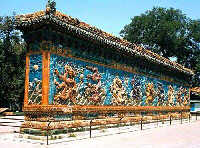Fengxiandian (Hall for Ancestral Worship)
Fengxiandian (Hall for Ancestral Worship) was built in 1656 during the Qing Dynasty. It has a front hall and a rear hall, which are connected, by a lobby. Its main function was to offer sacrifices to imperial ancestors. Grand sacrifices ceremonies would be held in its front hall on important occasions. On the days of their ancestors' birth, death and traditional festivals, ceremonies would be held in the rear hall.
Now the hall is open to the public as Clock and Watch Exhibition Hall. Different kinds of clocks and watches were given as gifts to the imperial family by foreign envoys in the Qing Dynasty, worth seeing.
Dongliugong (Six Eastern Palaces)
Dongliugong (Six Eastern Palaces) consists of Jingrengong (Palace of Great Benevolence), Chengqiangong (Palace of Celestial Favour), Yonghegong (Palace of Eternal Harmony), Jingyanggong (Palace of Great Brilliance), Zhongcuigong (Palace of Purity) and Yanxigong (Palace of Lasting Happiness).
The palace complex stands on the east side of the Inner Court. Most of the palaces were restored in the 17th century. These palaces were also the living quarters of the imperial concubines. Now mostly of them have been turned into exhibition halls where Chinese treasures used to be collected by the imperial family are displayed to the public.
Jingrengong (Palace of Great Benevolence) now holds exhibition of more than 500 pieces Bronze wares of ancient China with other two halls, Zhaigong and Chengsudian. Visitors will see magnificent bronze wares displayed there.
In Chengqiangong (Palace of Celestial Favour) and Yonghegong (Palace of Eternal Harmony), now the Pottery and Porcelain Exhibition Hall, visitors will be privileged to appreciate pottery and porcelain wares dated from the Neolithic Age to the Qing Dynasty.
Jingyanggong (Palace of Great Brilliance) has turned into an exhibition hall displaying lacquer wares, jade wares, stonewares, glasswares and metal wares etc., from the Ming and Qing dynasties. It is now Ming and Qing Crafts Exhibition Hall.
Nine Dragon Screen

Nine Dragon Screen is one of the three famous Nine Dragons Screens in China, the best and the biggest in China. The glazed tile screen was built in 1771 under the reign of Emperor Qianlong, and is 3.5 meters high and about 30 meters long. It composed of 270 pieces glazed tiles, depicting 9 surging dragons playing with pearls with a background of clouds and seawater. The relief screen applies yellow, blue, white and purple and looks gorgeous.
The screen indicates emperors' supremacy by arranging nine dragons in the front and 5 on the edge, since they did believe nine is the largest single number and 5 the middle, representing Heavenly Son in combination.
The belly of the third white dragon was inserted with a piece of wood. A Story tells that it was fired broken in the kiln, which meant nobody would be alive. A carpenter repaired it with a piece of wood.










